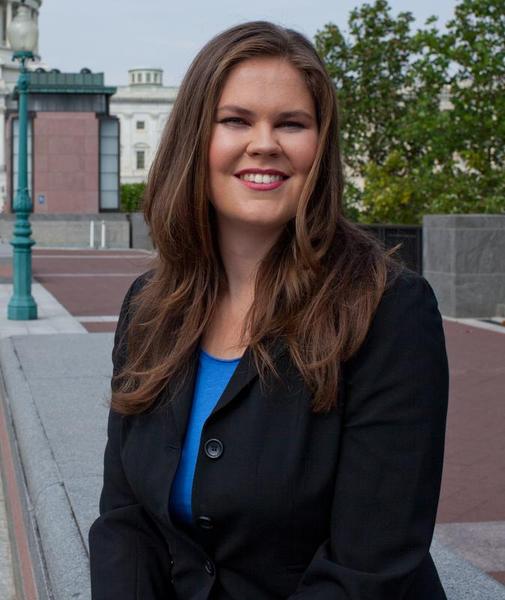
Retention

Eileen Pollack, one of the first women to graduate with a physics degree from Yale. She holds a master’s degree in creative writing from the University of Iowa.

Laura Wheeler Poms, assistant professor in global and community health at George Mason University.

Regan Blythe Towal, neuromorphic systems engineer.
Retention of Women in STEM
According to the Bureau of Labor Statistics website, women made up for 47 percent of the STEM workforce in 2013. Women have achieved—and sometimes surpassed—gender parity in healthcare as well as in life, physical and social sciences, but are still underrepresented in architecture, engineering, computer and mathematical fields.
In 2013, a staggering 74 percent of healthcare practitioners were women while only 14 percent of architects and engineers were women.
Eileen Pollack became one of the first women to earn a physics degree from Yale. Despite graduating summa cum laude in 1978, Pollack never worked as a physicist. She went on to graduate with a master’s in creative writing from the University of Iowa.
“I got more encouragement to be a writer literally the first class I took in creative writing than I did in all of my four years of physics.”
According to Pollack, “Scientists—even female scientists—think, ‘Oh, no. We don’t encourage anyone to go on because it is so difficult and you have to give up so much.’”
Pollack is currently taking a break from teaching at the University of Michigan to write her forthcoming book “Approaching Infinity: a Memoir About Women in Science” which tackles the multifaceted issue of the underrepresentation of women in science and engineering fields.
Many of the girls and women that Pollack has interviewed face prejudice at every stage of the educational and professional ladder. Pollack struggled to catch up to her male peers at Yale because she had been forced to teach herself calculus. Although advanced science and math courses are now more accessible, they are not necessarily more welcoming. One Yale student admitted that since she was the only girl in her high school physics class, her teacher assured her that she would be graded on a special “girl curve” because he did not expect her to keep up with the boys.
Social cues and biases from peers and teachers are often a factor in student performance and confidence in a subject. Since science and math scores are so dependent on a solid foundation, many girls are doomed to fall behind.
As evidenced by a 1998 study at the University of Michigan, women’s test scores are significantly worse than their male peers when told beforehand that the men, despite being similarly qualified, will outperform them.
Alice Hogan, former program director of the National Science Foundation’s ADVANCE program that works to improve working environments for women in higher education fields, says that social climates coupled with the different levels of exposure to science and math education between boys and girls create a “crisis of self-doubt”.
A lack of encouragement from their peers, bosses, or mentors—as in Pollack’s case—often leads to a “brain drain” from the scientific fields to other professional jobs.
“It’s a complicated situation, but I think it’s not something that we can afford to ignore because we’re obviously missing out on a lot of talent,” Hogan says. Dr. Laura Poms, assistant professor in global and community health at George Mason University, says, “A lot of STEM stuff is perseverance and sticking to it when it gets really challenging.”
Poms stresses the need for formal mentoring relationships in order to retain women in the workforce, but recognizes that it is difficult to find a balance, “So if there’s not a female in place, it makes it much more difficult and sometimes the men feel funny about it because… they tend to tippytoe around things like sexual harassment in interpersonal working relationships and stuff and sometimes it’s not clear to them how much is too much interaction and how much is not enough.”
Regan Blythe Towal, neuromorphic systems engineer, says that she is often the only woman in the room at work meetings, but that she felt most discriminated against while applying for jobs. Since Regan is an ambiguous name, the interviewer thought that Towal was a man and did not try to hide his confusion and disappointment at the sound of Towal’s voice.
Towal says, “I later learned that that particular group had no women in it and potentially had a bias, but there was a pretty big red flag there right from the start.”
Pollack asserts that the social climate in both higher education and in the workforce contributed to her decision to change her career path, “My lack of confidence, my lack of being encouraged, my sense that I didn’t fit in, that this wasn’t something girls did. If each of the girls in the room—not every single one of them, but most of them—still felt that way, so even if you had three girls in the room instead of one, it didn’t matter that much if each still felt that she didn’t belong.”
When it comes to improving work environments for women, Hogan says, “It is possible to change climate, but it takes a very long time.”
If you want more information on Pollack’s work, follow the link to her New York Times article.
